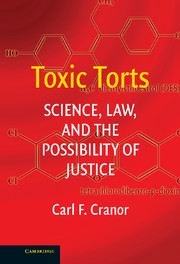Book contents
- Frontmatter
- Contents
- Preface
- 1 The Veil of Science over Tort Law Policy
- 2 Legal Background
- 3 Institutional Concerns about the Supreme Court's Trilogy
- 4 Studies of Toxicity and Scientific Reasoning
- 5 Excellent Evidence Makes Bad Law: Pragmatic Barriers to the Discovery of Harm and Fair Admissibility Decisions
- 6 Science and Law in Conflict
- 7 Enhancing the Possibility of Justice under Daubert
- 8 Is Daubert the Solution?
- Bibliography
- Index
1 - The Veil of Science over Tort Law Policy
Published online by Cambridge University Press: 08 January 2010
- Frontmatter
- Contents
- Preface
- 1 The Veil of Science over Tort Law Policy
- 2 Legal Background
- 3 Institutional Concerns about the Supreme Court's Trilogy
- 4 Studies of Toxicity and Scientific Reasoning
- 5 Excellent Evidence Makes Bad Law: Pragmatic Barriers to the Discovery of Harm and Fair Admissibility Decisions
- 6 Science and Law in Conflict
- 7 Enhancing the Possibility of Justice under Daubert
- 8 Is Daubert the Solution?
- Bibliography
- Index
Summary
INTRODUCTION
A significant, unseen revolution in the tort (personal injury) law is in progress. It is hidden from the public, except for those litigating toxic tort issues and well-informed researchers. These legal changes are difficult to discern because they are veiled behind a fabric of scientific complexity and detail, as well as arcane legal procedures that are not well known and are difficult to penetrate. Yet this veil must be lifted, the scientific and legal issues understood and put into perspective in order to appreciate the policy modifications in our legal system that can substantially affect the safety of ordinary citizens, both plaintiff and defense bars, corporate behavior, and fundamental legal relationships between citizens. This revolution involves science, law, and the possibility of justice for those who have been injured by the actions or products of others. What is the relationship among science, law, and the possibility of justice that it poses a problem?
Ordinarily, science has nothing to do with justice. Science provides one of the most reliable means for investigating empirical claims and producing comparatively objective evidence about them. Scientific research has resulted in considerable accumulation of knowledge about the world, in a substantial track record of predicting observable events, and as a consequence in “huge advances in human understanding [of the natural world and forces in it] … over the ages.” Scientific research greatly informs our understanding of human and animal biology, our environment and the larger world around us.
- Type
- Chapter
- Information
- Toxic TortsScience, Law and the Possibility of Justice, pp. 1 - 30Publisher: Cambridge University PressPrint publication year: 2006



